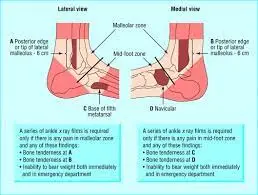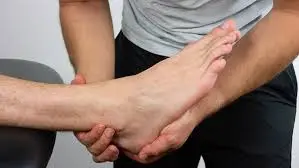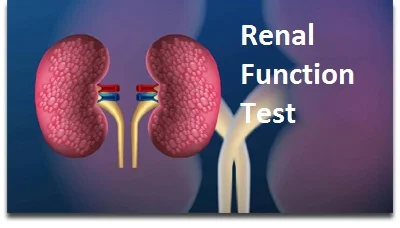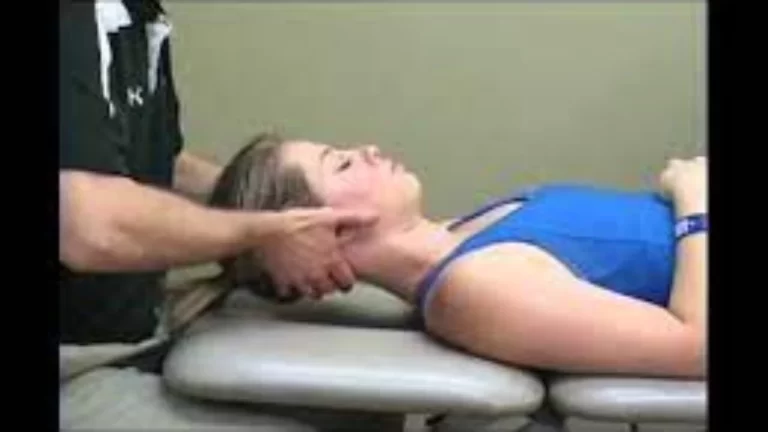Ottawa Ankle Rules Test
Table of Contents
Introduction
The Ottawa Ankle Rules define the need for radiographs in acute ankle damage. Both the general public and sportsmen frequently suffer from ankle sprains. According to estimates, there are 25,000 ankle sprains every day in the USA, or one for every 10,000 people.
An ankle sprain occurs more frequently in females than in males (13.6 vs. 6.94 per 1,000 exposures), in children than in adolescents (2.85 vs. 1.94 per 1,000 exposures), and in adolescents than in adults (1.94 vs. 0.72 per 1,000 exposures, according to a meta-analysis by Doherty et al. in 2014.
In emergency rooms, treating ankle sprains is a common thing. Although less than 15% of ankle fractures result in a clinically significant fracture, doctors used to routinely take radiographs for all ankle injuries, which increased healthcare expenses. To assist doctors in determining which patients should have an X-ray after suffering an acute ankle injury, the Ottawa Ankle Rules were developed.
The Ottawa ankle guidelines are a reliable tool for excluding midfoot and ankle fractures, according to the evidence. The device has a sensitivity of approximately 100% and a low specificity, and its employment ought to result in a 30–40% decrease in the amount of pointless radiographs. Less than 1% of patients who initially exhibit none of the symptoms will actually have a fracture.
Clinically relevant anatomy

Ankle sprains typically happen in the lateral, or outer, part of the ankle
Three lateral ligaments are present.
Calcaneofibular ligament (CF), posterior talofibular ligament (PTF), and anterior talofibular ligament (ATF).
In a lateral ankle sprain, these three ligaments are frequently strained or damaged.
Causes of an ankle sprain
Ankle sprains usually come on by overuse of the ankle. These actions often involve the foot rolling, rotating, and twisting.
Sports having the capacity to stand on another person’s foot, such as Netball, basketball, volleyball, or the Australian Football League, carry the highest risk of fractures.
Sprained ankles can also happen as a result of commonplace actions like stepping off a curb or falling on ice, as well as any high-velocity contact (such as in a car accident).
Variables
Five elements to test are:
Bone soreness around the distal 6 cm of the fibula’s posterior margin or the lateral malleolus’ tip
Bony soreness at the distal 6 cm of the medial malleolus/tibial posterior edge
Bony soreness at the fifth metatarsal’s base
Tenderness of the navicular bone
inability to bear weight for four steps at the first exam and soon following the injury
Technique of Use
A foot X-ray is only necessary if:
The malleolar zone is pain-free; any one of the following; and
Tenderness in the medial malleolus or along the distal 6 cm of the posterior border of the tibia, OR
Tenderness in the bones at the distal 6 cm of the fibula’s posterior border or at the lateral malleolus’s tip, OR
a four-step incapacity to bear weight both right away and while in the emergency room.
A series of foot X-rays are suggested if:
No pain is present in the midfoot zone, and any one of the following
sensitivity to touch at the base of the fifth metatarsal (for injuries to the feet), OR
navicular bone soreness (in cases of foot injury), OR
a four-step incapacity to bear weight both right away and while in the emergency room.
It should be emphasized that some groups are not allowed to do the test, especially pregnant women and those who have a reduced ability to do so (such as those who have had a head injury or are intoxicated). The Ottawa Ankle Rules should be used with children over 6 (98.5% sensitivity), according to several research. Their value for younger children hasn’t yet undergone a rigorous investigation, though.
The initial requirements were solely developed for ankle and foot injuries, but comparable regulations, such as the Ottawa knee rules, have been created for other ailments.
Recommendations
Be careful to correctly implement the Ottawa Ankle Rules by…
the whole distal 6 cm of the tibia and fibula were felt
keeping in mind how important medial malleolar soreness is
Only apply the regulations to those over the age of 18, make sure to provide written instructions, and urge patients to return in 5-7 days if their pain or capacity to walk persists.
Usefulness
The rules have been proven to have a very low percentage of false negatives and extremely high sensitivity and moderate specificity. Evidence demonstrates that the criteria are a reliable tool for eliminating ankle and midfoot fractures, resulting in fewer pointless examinations and shorter stays in emergency rooms.
According to the initial examination, the test was 100% sensitive and decreased ankle X-rays by 36%. These results were confirmed in a subsequent experiment including more patients. A multi-center research that followed investigated whether it would be possible to apply the guidelines on a larger scale. Unfortunately, it does not seem that educating patients about the regulations will assist in decreasing hospital visits.
Evidence
The Ottawa Ankle Rules’ pooled sensitivity was determined to be 97.6% in a comprehensive evaluation of 27 investigations conducted by Bachmann et al., with a median specificity of 31.5%. In comparison to children, adults had a pooled negative likelihood ratio for the ankle and midfoot of 0.08 and 0.08, respectively. The chance of a fracture after negative testing after the Ottowa Ankle Rules were put into place was estimated by the authors to be less than 1.4% using these ratios on the stated 15% fracture prevalence. The tool, according to the scientists, should result in a 30–40% decrease in the number of unneeded radiographs.
Reliability
In order to identify malleolar fractures, the Ottawa Ankle Rules were shown to have sensitivities of 1.0 (95% confidence interval (CI),.95-1.0) and 1.0 (95% CI,.82-1.0) respectively.
Accuracy
When applying the Ottawa Ankle Rules, a comprehensive evaluation of 27 studies indicated a 1.73% (95% CI, 1.05-2.75) risk of a fracture following negative testing. Less than 48 hours after an accident, the fracture probability increased to 1.05 (95% CI:.35-3.24) when it was used.
Validity
The Ottawa Ankle Rules had a sensitivity of 1.0 (95% CI,.95-1.0) for malleolar fractures and 1.0 (95% CI,.82-1.0) for midfoot fractures in children aged 2 to 16.
Clinical Significance
The relative decrease in ankle radiography decreased by 28% when the Ottawa Ankle Rules were applied in the emergency room or clinic environment, while it increased by 2% in a control scenario where the rules were not applied (P.001). At an intervention hospital, foot radiography decreased by 14% while increasing by 13% at the control hospital (P .05. A reduced predicted total medical expenditure for doctor visits and radiography (P.001) and significant changes in the amount of time spent in the emergency room (P.0001) were also discovered.
Relevance for Physiotherapy
Physiotherapists are increasingly the initial point of contact for patients, and testing out fractures is a major issue for practitioners in this circumstance. The Ottawa criteria can assist practitioners in clinically determining if radiological imaging is necessary since acute foot and ankle injuries can make it challenging to rule out bone damage.
FAQ
What are the three ankle rules in Ottawa?
Ankle Sprains
According to the Ottawa Ankle Rules, x-rays should be taken if there is pain in the malleolar zone and either A) bone soreness at the distal 6 cm of the fibula or B) bony tenderness at the distal 6 cm of the tibia, or C) the inability to walk four steps following the injury.
How many steps are in the Ottawa ankle rules?
The Ottawa Ankle Rules (OAR) were developed to assist doctors in determining whether patients with traumatic injuries would benefit from an x-ray. The goal of the current study was to confirm the validity of the OAR’s four-step weight-bearing rule as the only criteria.
What is the percentage of the Ottawa ankle rule?
Adults have confirmed the Ottawa ankle guidelines with 100% Sensitivity. The Ottawa Ankle guidelines have been validated in children aged 1 to 15 with a sensitivity of 36-47% and specificity of 98–100% for clinically severe ankle injuries; other investigations, however, have found lower sensitivity levels.
What is the cut-off age for the Ottawa ankle rule?
In a prospective, multicenter validation study that took place in 2003, the rule was applied to kids between the ages of 2 and 16. According to that study, the decision rule was 100% sensitive in identifying 70 fractures out of 750 children, had a specificity of 42.8%, and may have resulted in a 31.2% decrease in the use of X-rays.
What are the five Ottawa guidelines for fractures of the ankle?
Bony pain along the distal 6 cm of the posterior fibula or tip of the lateral malleolus is the fifth component of Ttst.
Tenderness at the distal 6 cm of the medial malleolus and the posterior margin of the tibia.
At the fifth metatarsal base, the bone is sensitive.
navicular area of the bone is sensitive.
What is the purpose of Ottawa rules?
The Ottawa Ankle Rules were created with the goal of detecting severe fractures with a high degree of sensitivity. Test sensitivity is the proportion of all patients with the illness that have a positive test result when compared to an established benchmark.
What are the ankle points in Ottawa?
The Ottawa ankle rules
any of the following Tenderness in the medial malleolus or along the distal 6 cm of the posterior margin of the tibia. Tenderness in the bones around the distal 6 cm of the fibula’s posterior border or the lateral malleolus’ tip, OR.
What is the Ottawa knee rule?
The Ottawa Knee Rules are a clinical decision-making method for deciding whether patients with knee pain after trauma need radiographic imaging. If any of the following holds true, a patient with knee discomfort is eligible for knee radiographs: at least 55 years old. Identify the fibular head as tender.
Reference
- Ottawa Ankle Rules. (n.d.). Physiopedia. https://www.physio-pedia.com/Ottawa_Ankle_Rules
- Ottawa ankle rules. (2023, September 5). In Wikipedia. https://en.wikipedia.org/wiki/Ottawa_ankle_rules
- Pires, R., Pereira, A., Labronici, P., Figueiredo, L., Godoy-Santos, A., & Kfuri, M. (2014). To determine if radiographs are required after foot and ankle sprains, Ottawa Ankle Rules and surgeon perception are used. Annals of Medical and Health Sciences Research, 4(3), 432-435. https://doi.org/10.4103/2141-9248.133473
- Clingenpeel, J., Herbert, K., & Greenfield, B. (2018, January 1). Extremity Trauma. Elsevier eBooks. https://doi.org/10.1016/b978-0-323-46215-0.00028-8
- Ottawa Ankle Rules (OAR). (n.d.). APTA. https://www.apta.org/patient-care/evidence-based-practice-resources/test-measures/ottawa-ankle-rules-oar







